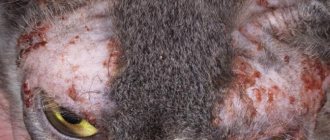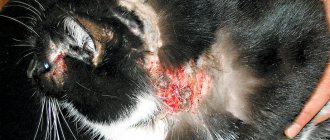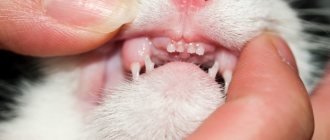Ears are considered one of the main organs of a cat. An animal's hearing is much better than a human's, but cats suffer from ailments of the auricle no less than people. Classification of ear diseases in cats:
- Diseases that appear as a result of damage to an organ by parasites.
- Infectious diseases.
- Diseases resulting from inflammation.
Many owners of pets are interested in the question of what ear diseases can occur in cats?
Ear diseases in cats: symptoms and treatment
Characteristics of ear diseases
Concha hematoma in cats
Appears against the background of received bites from other animals or blows. A bruise forms if the vessels of the auricle rupture. In this case, the area begins to fill with blood. Due to the pressure, the auditory organ swells for a few minutes after the rupture, causing a feeling of discomfort.
If proper treatment is not started at the first symptoms, the neoplasm remains, and subsequently the accumulated fluid passes into the scar tissue phase. This phenomenon can externally irreversibly change the organ of hearing. The size of the tumor depends on the pressure and the level of compliance of the tissues located near it. Hematomas occur on the inner plane of the ear and are much less common externally. Damaged ears increase in volume, droop; if you palpate, they are hot and painful. If the disease is left to chance, the pain increases, and bruising can lead to necrosis of the ear cartilage.
Concha hematoma in cats
Treatment consists of removing the hematoma with a syringe or surgery. You cannot do this on your own! After opening the hematoma, the doctor will prescribe a course of antibiotic such as Ampicillin.
Lymphatic extravasation of the ears in cats
It has similar symptoms and occurs for the same reasons as a hematoma. The only difference is in the method of therapy. When you are sick, applying cold or heat is harmful. If lymph accumulates, the liquid is also withdrawn with a syringe. When the procedure does not give a positive result, surgery is necessary. During the operation, the doctor trims the hair, treats an area of skin with an antiseptic, then cuts the skin, removes the contents and finally applies stitches. After the operation, antibiotics are also prescribed for 3-4 days.
Ear scabies in cats
Belong to the most common ailment. The disease is also called otodectosis, which is characterized by brown “islands” on the inside of the ear. They are similar in appearance to coffee. The disease is caused by ticks, which can be easily seen. It is necessary to carry out treatment in a timely manner so that there is no inflammation and the animal does not die.
Otodectosis of the ears
When the disease is advanced, the animal becomes apathetic, body temperature rises, and pathological conditions of the nervous system—convulsions—occur.
How to identify ear mites?
The tick looks like a red, brown parasite. The main signs of the parasite include twitching of the ears, turning the head from side to side, bad odor from the ear, and the presence of clusters of brown color. The animal will scratch its ears, so wounds may appear in this area. In this case, a veterinarian will help the pet owner. The doctor will determine the disease, clarify the diagnosis, and prescribe therapy. Self-medication will only harm your cat's health, but there is one option that can be used for treatment at home.
How to treat otodectosis at home?
The procedure for treating ear mites does not require special knowledge and skills, so everything can be done at home. But when we talk about “advanced cases,” it is best to contact a veterinarian straight away.
How to carry out treatment? Be sure to clean the ear of crusts and pus before using medications. Use hydrogen peroxide or Chlorhexidine applied to a cotton swab. To clean the ear, you can take cotton swabs that are moistened with alcohol. The procedure is repeated 1-2 times a day. Only after the cat’s ears have been treated with alcohol or peroxide can the medicine be used as prescribed by a veterinarian.
Treatment consists of cleaning the ear with a cotton swab containing medication. Before visiting a doctor, it is permissible to use an effective long-acting product against fleas, lice, ticks and other skin parasites. Before instilling drops of “Bars”, “Tactic”, “Amit”, “Frontline Spot-on”, “Acaromectin” or “Otoferonol”, you need to clean your ears from old crusts. Additionally, “Stronghold” drops are added to the withers.
Otoferonol drops
Important! Bars drops for treating ticks are especially effective. They must be applied to the skin in the neck area to prevent the animal from licking it off.
Video - Otodectosis in cats
Otitis in cats
Otitis is characterized by inflammation. The symptoms resemble the same signs as in the case of ticks. These are redness, high levels of wax in the ears, irritation. scratch its ears so often . The disease should only be treated by a veterinarian, since complications may occur if the treatment is improper. The pet owner must take the cat to a veterinarian and follow the doctor's recommendations.
Treatment consists of treating the ear with Chlorhexidine and removing wax using an exudate solution. After removing all the crusts, the ear is instilled with Otipax, Sofradex or Anandin Plus .
Otipax drops
Neoplasms in the auricle
Neoplasms appear more often in older animals in the area covering the ear canal. Such growths are considered benign. However, an ulcerated bleeding tumor in the external auditory canal is difficult to treat, and the animal is often euthanized. Tumors look like small nodules in which an infectious process occurs. The doctor may order a collection of cells or tissues (biopsy) for diagnostic purposes. In some cases, benign growths can be treated with surgery, but not in an advanced stage.
Treatment involves prescribing a course of antibiotics and corticosteroids. Additionally, there are painkillers like Motrin or Advil.
Painkiller Motrin
Eczema or dermatitis of the ear
This problem refers to inflammation of the outer ear. The factor of the disease is considered to be the entry of a foreign body into the organ, the penetration of liquid. The pet feels unpleasant irritation. The skin swells and turns red. A dark-colored discharge with an unpleasant odor is noticeable in the area. The animal holds its head on its side.
In this case, you can remove the foreign body from the ear using a syringe with three percent hydrogen peroxide. Wet areas are treated with astringents, such as a 2% silver solution, 3-5% solution of picric or boric acid. In case of severe itching, Cordiozol is used and corticosteroid ointments such as Hydrocortisone and Geocorton are prescribed.
But in any case, it is better to consult a doctor who will rinse the ear and prescribe the necessary medicine.
Inflammatory processes
Let's consider inflammatory processes in the ear and their types. With otitis media, inflammation occurs in the ear. There are 3 types:
- external;
- middle;
- interior.
Treatment of otitis media in cats at home
All types differ from each other in the prerequisites for their occurrence. In addition, it should be noted that there is a variation of the disease: the outer and inner ear.
External inflammation. With this type, the first step is to exclude infection with parasites, especially ticks. With external inflammation of the ear, swelling, redness, and severe irritation appear, causing the cat to try to scratch the area with its claws. When the disease is detected very late, the animal’s hair may fall out and pus may ooze from the affected area. There are several factors for contracting this type of disease:
- as a result of injury or splinter;
- when the animal is hypothermic;
- the disease may appear as a result of an infectious process caused by pathogenic microorganisms or viruses;
- due to fungus;
- accumulation of wax in the ear;
- allergy.
Streptococci and staphylococci can provoke inflammatory processes in the ears of animals
Inflammatory damage to the auditory tube, which causes deterioration in the ventilation of the tympanic cavity with the formation of otitis media. This type of illness is rare. It may appear as a complication of external inflammation if the therapy was carried out incorrectly. The cause of the appearance may also be an injury.
Reference! The initiators of the disease are often streptococci and staphylococci. The disease occurs with purulent discharge in an acute form.
Streptococci and staphylococci can provoke inflammatory processes in the ears of animals
Signs and treatment
The severe consequences of inflammatory processes are manifested by lifelong pathology of coordination, the animal loses hearing. The signs of the disease are as follows:
- the cat refuses to eat, tilts its head in the direction affected by the disease;
- swelling is noticeable;
- increased body temperature;
- acute purulent discharge;
- the animal walks hesitantly.
Does your cat refuse to eat? She's probably unwell
Inflammation of the inner ear appears against the background of complications of previous types of ear disease. The pathology process is severe, with pronounced symptoms:
- hearing loss;
- problems with the direction of body movement;
- lack of appetite;
- when palpating the temples, pain occurs.
A long course of antibiotics is prescribed as treatment. This may be a series of cephalosporins for 25-30 days with further adjustment of therapy in accordance with the results of bacteriological studies. In case of relapse, surgical treatment or drainage of the ear cavity is often used.
Clinical picture
You can suspect a cat has otitis media by its behavior. She combs her ears, tries to cover them, tilts her head towards the sore ear.
When examining the ears, redness and swelling of the outer side of the ear canal, transparent or dirty yellow, gray, black unpleasant-smelling discharge, scratching and ulcers appear. These are signs of otitis externa, which is a good reason for a trip to the veterinary clinic.
Otitis media and internal otitis are characterized by the following symptoms:
- ear pain, painful shootings, because of which the cat jumps and gets scared;
- temperature increase;
- lack of appetite, depressed state;
- the affected ear is slightly bent;
- discharge of pus from the ear, characteristic squelching when pressing on the shell;
- sagging lips and eyelids on the side of the inflamed ear.
If otitis media takes a chronic form, the pet becomes restless due to periodic pain.
When examined with an otoscope, thickening of the skin around the entrance to the ear and near the auditory membrane is noticeable.
Symptoms of ear diseases
Whatever the disease, the animal always shows some symptoms with which the doctor can make a diagnosis. Therefore, when it comes to ear diseases, veterinarians identify several main signs of illness.
- Tilt of the head to the side.
- The pet regularly tries to scratch its ears because it is tormented.
- The cat is apathetic.
- Any ear disease is characterized by discharge from the auditory organs.
- The pet often presses its ears to its head.
- The temperature rises.
- The auricle is red, and fluid accumulation may be noticeable on its surface.
Symptoms of ear diseases in cats
The main thing at the first changes in the cat’s well-being is to visit a veterinarian, who can immediately identify the cause and prescribe competent therapy.
Ear scabies in cats: treatment, photos, how to treat them
Not only people, but also pets can become victims of parasites. Some owners mistakenly believe that a clean domestic cat will never become infected with a parasitic disease. Ear scabies in cats, of course, most often affects homeless animals, but pets are also not immune from its occurrence.
Scabies in cats
The causative agent of any type of scabies, and there are several of them in cats, is the scabies mite. This parasite is very small in size and difficult to see with the naked eye.
The lack of speech in animals makes it difficult for owners to understand as quickly as possible what is bothering their pet.
Scabies is not a harmless disease, since a pet suffering from it becomes aggressive, experiences a constant feeling of itching, loses appetite, loses interest in active and fun games, remains in a lethargic and depressed state, and is also capable of inflicting quite noticeable wounds on itself in the process of scratching the itchy ones. regions.
The main characteristic signs of scabies in a cat are the following:
- The animal constantly itches and chews its own fur and skin in an attempt to get rid of parasites.
- Papules and lumps appear on the skin, and bumps in the area of the skin around them turn red.
- The skin peels and hair may fall out.
But it is almost impossible to make a correct diagnosis on your own, since the above signs are similar to other diseases in pets, for example, food allergies or dermatitis.
If this parasitic disease is suspected in a pet, loving and caring owners should take it to the veterinarian as soon as possible.
A specialist must take a skin scraping from a cat for analysis in order to make an accurate diagnosis.
After diagnosing a certain type of scabies, which may be the following:
- Sarcoptic mange.
- Notoedrosis.
- Otodectosis (ear scabies).
The veterinarian prescribes medications for the pet, prescribes a regimen and duration of treatment.
The owner, who has taken upon himself the responsibility of treating a sick animal, also needs to take precautions, since some types of cat scabies are contagious to him . Therefore, it is necessary to treat your pet with medications strictly using rubber gloves.
The most likely cases of scabies infection are in those cats whose owners let them go for a walk and socialize with other animals . The disease can also appear in homes where there are a large number of pets. Very often, representatives of the class of birds become carriers of the disease.
Most often, cats become victims of ear mites. Below is a photo of ear scabies in cats.
Consequences of ear scabies in cats
This type of scabies is very dangerous for a pet, so at the slightest suspicion you should immediately show your pet to a specialist.
Ear scabies in cats and kittens
This type of disease is caused by microscopic mites of the genus Otodectes cynotis. In addition to cats, dogs, foxes, arctic foxes and other small predators can suffer from this disease, and very rarely humans.
This parasite feeds on the epidermis and blood of the animal, while gnawing through many passages in the skin, causing the cat to feel severe itching. The ear mite has a very small size from 0.2 to 0.5 mm, an oval body shape, and a translucent color.
The disease affects the outer ear, but if left untreated, the eardrum suffers, which can lead to deafness in the pet . The life cycle of the parasite lasts about 25 days, during which they secrete a special secretion into the ear of a cat to maintain optimal humidity, which, together with the products of their vital activity, causes inflammation.
A domestic cat or cat can become infected with this parasite after contact with other animals, through the hands and personal items of the owner, from bedding, toys belonging to infected pets.
Most often, young cats and cats under 12 months of age suffer from ear scabies; the disease is most common in spring and summer, but infections also occur in the autumn-winter period.
Signs at the beginning of the disease manifest themselves very weakly, but then become more noticeable:
- The cat begins to actively scratch the affected areas, shaking its head vigorously, trying to throw off the parasites.
- The itching does not give the pet peace, so large and deep scratches appear inside and outside the ear as a result of scratching.
- The animal's earwax takes on a dark brown color; its usual color is light yellow.
An advanced disease threatens the pet with hearing loss, pus may flow from the ear, a bacterial infection may develop, and the ear itself becomes hot when touched.
Since neglected ear scabies threatens your pet with serious complications, it needs to be treated urgently, after consulting with a specialist. The veterinarian takes the contents of the ear for analysis using a cotton swab, makes a diagnosis and prescribes treatment.
Treatment of ear scabies in cats is very successful thanks to medications and timeliness.
How to Treat Ear Scabies in Cats
The question of how to treat ear scabies in cats arises for many owners of these furry pets. It occurs not only because the animal experiences suffering from the disease, which one wants to immediately alleviate, but also because its presence on the pet’s skin looks extremely unaesthetic, as in the photo above.
To kill scabies mites, your veterinarian may prescribe medications such as Tsipam , Aurican and Amitrazine . Before dripping these drops, it is necessary to carefully treat the auricle; if the disease is not very advanced, the pet’s owners can do this on their own, but in severe cases this is done by a specialist.
General ear treatment is carried out as follows:
- Before cleaning, drop vegetable oil into the ear and gently clean it with a cotton swab, removing crusts, wax, and mite excrement. For instillation, you can use products such as Rosinka or Fitolar .
- Then the ear is thoroughly wiped with cotton wool and a bandage.
- Drops are dripped according to the scheme prescribed by a specialist.
- If there are suppurations, then I treat them with ointments containing an antibiotic, for example Lincomycin or Streptomycin .
Despite the fact that at first glance, getting rid of the disease is not very difficult, any pet owner should understand that preventing it is much easier.
To prevent your pet cat from suffering from ear mites, veterinarians recommend using antiparasitic drugs, such as Bars or Stronghold , which can be dripped onto the pet’s withers once a month. This is especially true for those pets that the owners take with them to the dacha, on a visit or on trips.
Also, pet owners should wash their hands before picking up their cat, especially after playing with other people's animals. A loving and caring owner should regularly clean his pet's ears of dirt and wax, and also ensure that the pet's nutrition is complete and balanced. To maintain your cat's immunity, it is recommended to give them vitamins.
Source: https://101parazit.com/nasekomye/chesotka/chem-lechit-ushnuyu-chesotku-u-koshek.html
Treatment
Let's consider how to treat ear diseases in cats? The first step is to get rid of the hair around the ear and from the inside. The wool is cut and treated with 3% hydrogen peroxide. These are all measures that a cat owner can personally take at home. The main treatment is prescribed by a veterinarian. How and with what to treat a cat depends on the doctor’s opinion.
If ear inflammation is caused by bacteria, drugs in the form of drops are used. These drops contain an antibiotic. When a cat's ear disease is associated with infection by parasites, medications against insects and ticks must be prescribed.
Only a veterinarian can prescribe the correct treatment
When an animal has allergies, it is necessary to use pharmaceuticals that relieve irritation and inflammation. In some cases, you may need to administer antibiotics in the form of injections or oral administration.
If there is a hematoma, it is necessary to puncture it with a needle to allow the blood to come out. This way you can prevent further accumulation of pus. Then the damaged area is washed by injecting an antibiotic into the cavity. Certain ear diseases are treated exclusively surgically, for example, in the case of a sudden narrowing of the ear canal resulting from prolonged inflammation.
Attention! When instilling drops, you must ensure that they are evenly distributed along the inner plane of the auricle. Then the ear is pressed against the skin and massaged a little.
Today, there are many substances available to treat ear mites in cats. Substances are divided into three types:
- preparations in the form of drops and powder;
- aerosols and ointments;
- injection.
Video - How to put drops in a cat's ear?
Medicines against ear mites in cats
To completely remove mites from cats' ears, it is recommended to use a medication. If they are not used, the pathogen may remain inside the ear canals. Since the parasite goes through several stages of development, a single use of medication may not help. Therefore, they are used repeatedly to destroy new individuals that have developed from eggs.
Ear drops
Treatment is carried out in several stages.
- Cleaning the external auditory canals from crusts, pus, scabs, and earwax. A veterinarian can help with this. In his office, he completely cleans the ear canal using special tools.
- Cleaning with antiseptics. A solution of furatsilin, chlorhexidine, and hydrogen peroxide will help get rid of bacteria and toxins. They not only destroy pathogenic microflora, but also wash out a certain proportion of parasites. The product is applied to a cotton swab. Directly pouring the solution into the ear is prohibited.
- Use of anti-tick medications. They are used in the form of ointments, drops, and gels. It is recommended to use drops during the daytime. They are applied strictly according to the instructions, up to three times a day. It is recommended to apply ointment or gel at night so that the drug has a long-lasting effect. They use Amitrazine, Tactic, Otoferonol.
- When the pathogen spreads strongly in the eardrum or inner ear, injectable drugs are used. One of them is Ivermectin. It is used only in extreme cases, since the active substance penetrates the liver and causes the destruction of some hepatocytes. Therefore, during therapy, biochemical blood tests are periodically taken to determine liver enzymes. You should follow the step-by-step instructions to avoid adverse reactions.
- Antimicrobial drugs with anti-inflammatory effects. One of them is Otonazole. The ointment not only has a bactericidal effect, but also treats fungal infections. It is used for active reproduction of pathogenic microflora.
- To relieve itching and eliminate the possibility of mites actively reproducing, oils and creams are used. They soften the skin and crusts formed on wounds. After their application, it is easier to remove foreign objects from the ear canal.
- Immunotherapy. They use Gamavit, Gamapren. They stimulate the synthesis of the cat’s own immune cells, thereby enhancing the destruction of pathogenic microorganisms. The animal is able to fight the infection on its own.
In addition to medications, diet is used during treatment. The pet's diet at this time should be varied. It should include all the beneficial substances, microelements, vitamins, and minerals necessary to strengthen the immune system.
Important! Cat ear mites can spread indoors. Therefore, from the moment parasites are identified, all household items are thoroughly disinfected. This eliminates the risk of re-infection.
Prevention of ear disease
Prevention of ear problems includes cleaning with substances prescribed by your veterinarian. This type of cleaning must be carried out continuously. Do not forget that the process of cleaning the ears should not cause pain to the animal. The entire procedure is done carefully so as not to injure the cat’s hearing organs. To avoid any unpleasant moments, you need to know what the prevention of ear disease in cats is. To clean your ears you need to:
- prepare tools, substances;
- will make sure that the cat is calm and not alarmed;
- wrap the animal in a towel to protect yourself from scratching with claws;
- It is necessary to drop a substance or lotion into the ear;
- after instillation, you should not pinch your ear too much and make massaging movements;
- After this manipulation, you can take a cotton swab and remove excess liquid.
When the treatment and cleaning of the ear is done correctly, the cat owner does not need to worry that the pet may develop complications. Teach your animal from childhood to constant ear examinations. Do this delicately, combining it with gentle stroking.
It is necessary to periodically prevent ear diseases
Ear washing lotions - “Otifri” and “Epi-otik”, as well as “Bars” lotion, in addition to 2 products from the German company Beaphar - can be obtained at any veterinary store. An interesting solution is the “Miss Kiss” sticks - these are ordinary sticks soaked in a medicinal agent.
Diagnosis of otitis media in cats
Only a veterinarian can make an accurate diagnosis. First, he examines the animal using an otoscope and determines the location of the inflammation. Looks to see if the eardrum and ear canals are damaged, checks for the presence or absence of tumors, inclusions, cysts, and assesses the amount of sulfur.
The veterinarian will then take a scraping of the skin to determine if there is a subcutaneous mite. Cytology requires a smear of ear discharge for culture. This helps determine the type of inflammation (what is caused by bacteria, fungi, parasites). Additionally, the cat's urine is taken for analysis. They do a general blood test and biochemistry. If an allergic nature of the disease is suspected, tests are performed to identify the irritant.
How to treat otitis media in cats
If brain damage, cystic neoplasms or a tumor are suspected, an X-ray of the head or MRI is done. Based on the data obtained, treatment is selected - drops, tablets, injections. If antibiotics are needed, the reaction of pathogenic microorganisms to specific groups of drugs is checked.
Prevention of otitis in cats
To prevent inflammation, regularly clean your cat’s ears and remove accumulated wax. Carry out the procedure with gauze napkins or cotton pads, without penetrating deep into the shells. Protect the animal from drafts, cold, and do not allow water to get into the ears while bathing. If they have a lot of excess hair, trim it off. Treat your cat for parasites every three months.
If otitis media appears, contact your veterinarian immediately. Treatment depends on the type of disease, but only a doctor can make a diagnosis. Self-medication is dangerous for your pet's health.











